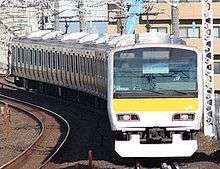Chūō-Sōbu Line
| Chūō-Sōbu Line | |||
|---|---|---|---|
|
| |||
|
An E231 series EMU on the Chuo-Sobu Line in central Tokyo in March 2008 | |||
| Overview | |||
| Native name | 中央・総武緩行線 | ||
| Type | Commuter rail | ||
| Status | Operational | ||
| Locale | Tokyo, Chiba prefectures | ||
| Termini |
Mitaka Chiba | ||
| Stations | 39 | ||
| Operation | |||
| Opened | 1932 | ||
| Owner | JR East | ||
| Depot(s) | Mitaka | ||
| Rolling stock | 209-500 series, E231-0 series, E231-500 series, E231-800 series, E231-900 series | ||
| Technical | |||
| Line length | 60.2 km (37.4 mi) | ||
| Track gauge | 1,067 mm (3 ft 6 in) | ||
| Electrification | 1,500 V DC overhead catenary | ||
| |||
The Chūō-Sōbu Line (中央・総武緩行線 Chūō-Sōbu-kankō-sen) is a railway line located in Tokyo and Chiba Prefecture, Japan. Part of the East Japan Railway Company (JR East) network, it operates on separate tracks along the right-of-way of the Chūō Main Line (Chūō Line (Rapid)) and Sōbu Main Line (Sōbu Line (Rapid)), providing service between Mitaka Station in the cities of Mitaka and Musashino and Chiba Station in Chiba.
The term Kankō (緩行 lit. "slow run") distinguishes local trains on the Chūō-Sōbu line from rapid service trains running on the Chūō Main Line between Mitaka and Ochanomizu and on the Sōbu Main Line between Kinshichō and Chiba.
Station list

- Except for certain limited express and seasonal trains, all local service trains stop at every station.
- Some Tokyo Metro Tozai Line trains have through service on the Nishi-Funabashi – Tsudanuma (mornings/evenings only) and Nakano – Mitaka sections.
- For information on limited express trains that make stops on the Chūō-Sōbu Line between Kinshicho and Ochanomizu, see their respective articles.
- For station information on the parallel rapid/express lines, see the Chūō Line (Rapid) and Sōbu Line (Rapid) articles.
- Legend
- ●: All trains stop
- ■: Some trains pass
- ▲: All trains pass on weekends and holidays
- |: All trains pass
Rolling stock
Trains used on the Chūō-Sōbu Line are based at Mitaka Depot.
- 209-500 series 10-car EMUs (yellow stripe) (since December 1998)[1]
- E231-0 series 10-car EMUs (yellow stripe) (since February 2000)[1]
- E231-500 series 10-car EMU (yellow stripe) (since 1 December 2014)[2]
- E231-800 series 10-car EMUs (light blue stripe) (on Tozai Line inter-running services between Mitaka and Tsudanama since 1 May 2003)[3]
- E231-900 series 10-car EMU (yellow stripe) (since 27 March 1999 as 209-950 series)[4]
 A Chūō-Sōbu Line 209-500 series EMU in April 2009
A Chūō-Sōbu Line 209-500 series EMU in April 2009 A Chūō-Sōbu Line E231-0 series EMU in April 2009
A Chūō-Sōbu Line E231-0 series EMU in April 2009 A Chuo-Sobu Line E231-500 series EMU in December 2014
A Chuo-Sobu Line E231-500 series EMU in December 2014 An E231-800 series EMU in December 2009
An E231-800 series EMU in December 2009 The sole E231-900 series EMU in October 2007
The sole E231-900 series EMU in October 2007
Rolling stock used in the past
- 101 series EMUs (yellow livery) (from 1963 until November 1988)[1]
- 103 series 10-car EMUs (yellow livery) (from 1979 until March 2001)[1]
- 201 series 10-car EMUs (yellow livery) (from 1982 until November 2001)[1]
- 205 series 10-car EMUs (yellow stripe) (from August 1989 until November 2001)[1]
- 301 series 10-car EMUs (light blue stripe) (on Tozai Line inter-running services from 1966 until 2003)
 A Chuo-Sobu Line 201 series EMU in May 2001
A Chuo-Sobu Line 201 series EMU in May 2001- A Chuo-Sobu Line 301 series EMU in February 2003
History
Women-only cars, designed to prevent gropers, were introduced on this line during morning peak periods starting on November 20, 2006.
References
- 1 2 3 4 5 6 JR首都圏通勤電車図鑑. Japan Railfan Magazine. Vol. 48 no. 570. Koyusha Co., Ltd. October 2008. p. 27.
- ↑ 中央総武緩行線でE231系500番台が営業運転を開始 [E231-500 series enters revenue service on Chuo-Sobu Line]. Japan Railfan Magazine Online (in Japanese). Japan: Koyusha Co., Ltd. 2 December 2014. Retrieved 2 December 2014.
- ↑ JR電車編成表 2016夏 [JR EMU Formations - Summer 2016] (in Japanese). Japan: Kotsu Shimbunsha. 20 May 2016. p. 96. ISBN 978-4-330-68216-7.
- ↑ 特集 209系 第2章へ [209 series - The second chapter]. Japan Railfan Magazine. Vol. 49 no. 576. Koyusha Co., Ltd. April 2009. pp. 9–47.
External links
| Wikimedia Commons has media related to Chūō-Sōbu Line. |
- Chūō-Sōbu Line (Japan Visitor) (English)








































.svg.png)